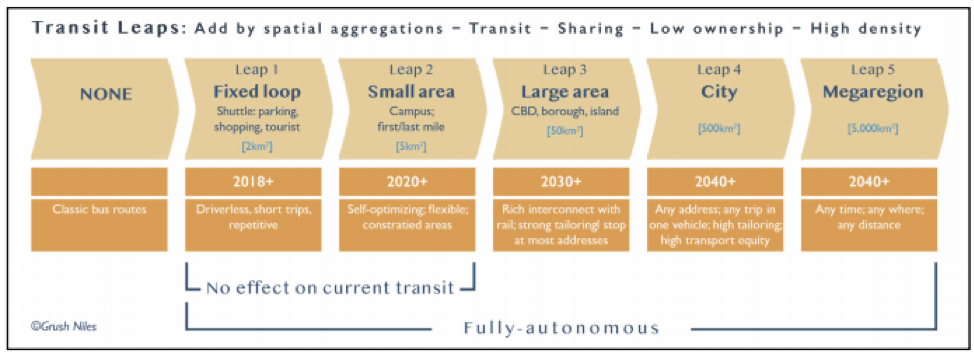- 408-924-7560
- mineta-institute@sjsu.edu
- Donate
AVs Have Arrived, So What's a Transit Agency to Do?
Innovations in automated and connected vehicles are poised to radically transform personal mobility. How will this transformation impact transit agencies? Mineta Transportation Institute’s (MTI) latest perspective: “Automated Vehicles have Arrived: What’s a Transit Agency to Do?” analyzes the ongoing innovations in automated and connected vehicles, commonly referred to as AVs, and how proactive transit agencies can maintain their existing mission while responding to changes on the horizon.
How ownership will settle out if vehicle fleets become fully robotic is unknown. Some scenarios predict wide utilization of highly optimized robotaxi fleets. Other scenarios start from the current state of primarily private vehicle ownership and consider a wide array of possibilities—ranging from massive sharing to just a slight increase.
While there is a celebrated upside to having driverless robotaxis provide all imagined passenger trips, it is unclear how to ensure transportation equity and access regardless of one’s ability to pay or mobility level. The ideal scenario for public transit planners would be an optimized, dense, and always available transit network that is also affordable for the rider.
Regardless, the mixture of varying levels of automated vehicles will create a complex planning environment. “We should expect at least 30 years of mixed fleets of varying levels of semi-automation,” says MTI Research Associate and author John Niles. He goes on to address the issues that will be faced in the coming years, including, distracted driving, complex and shifting transit infrastructure planning, and street re-organization among others.
In order for the public transit to remain a viable option, the industry must undergo a series of AV adaptations Niles refers to as “Transit Leaps.”

Figure. Transit Leap levels are described spatially rather than by level of autonomous operations.
Transit Leap implementations occur at the highest level of autonomous operations and allow public transportation to evolve with the AV technology. Each “leap” coincides with evolving AV technology while still maintaining the essential functions of the transit system, including accessibility and affordability for riders. Beginning with first-and-last mile applications, Transit Leaps could progress through larger and more capable roll-outs toward a long-run scenario of massive shared fleets that span urban regions. Adhering to an evolutionary model, transit agencies will be able to better manage the rapid growth of AVs as transportation drives into the future.
ABOUT THE MINETA TRANSPORTATION INSTITUTE
At the Mineta Transportation Institute (MTI) at San Jose State University (SJSU) our mission is to increase mobility for all by improving the safety, efficiency, accessibility, and convenience of our nation's’ transportation system through research, education, workforce development and technology transfer. We help create a connected world. MTI was founded in 1991 and is funded through the US Departments of Transportation and Homeland Security, the California Department of Transportation, and public and private grants. MTI is affiliated with SJSU’s Lucas College and Graduate School of Business.
ABOUT THE AUTHOR
John Niles is an MTI Research Associate at San Jose State University where he leads teams researching new planning processes for transit-oriented development, bus rapid transit incrementalism, park-and-ride advantages for transit ridership, as well as autonomous vehicle developments.
###
Contact:
Irma Garcia, MTI Communications & Workforce Development Coordinator
408.924.7560
-
Contact Us
San José State University One Washington Square, San Jose, CA 95192 Phone: 408-924-7560 Email: mineta-institute@sjsu.edu





